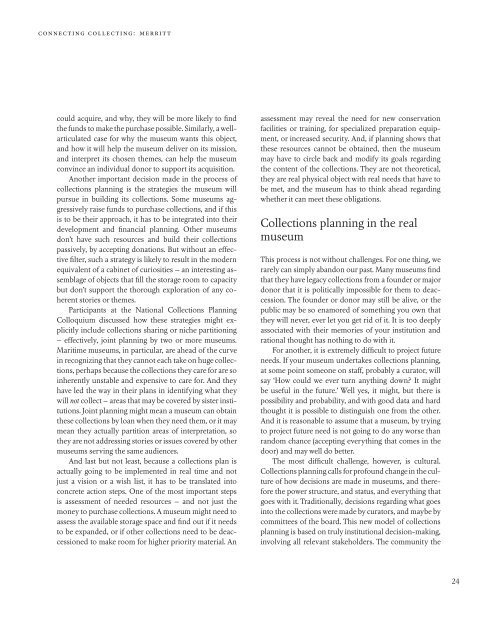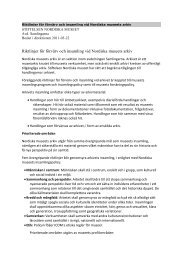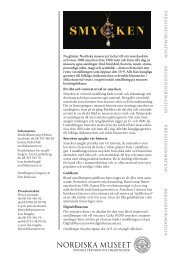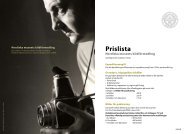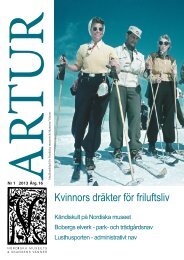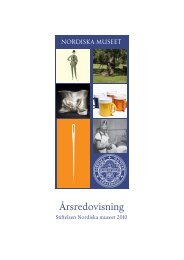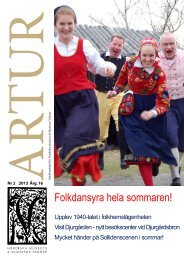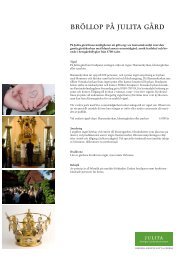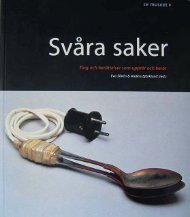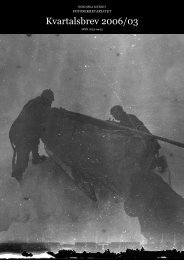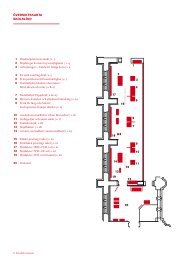Samdok - Nordiska museet
Samdok - Nordiska museet
Samdok - Nordiska museet
You also want an ePaper? Increase the reach of your titles
YUMPU automatically turns print PDFs into web optimized ePapers that Google loves.
connecting collecting: merritt<br />
could acquire, and why, they will be more likely to find<br />
the funds to make the purchase possible. Similarly, a wellarticulated<br />
case for why the museum wants this object,<br />
and how it will help the museum deliver on its mission,<br />
and interpret its chosen themes, can help the museum<br />
convince an individual donor to support its acquisition.<br />
Another important decision made in the process of<br />
collections planning is the strategies the museum will<br />
pursue in building its collections. Some museums aggressively<br />
raise funds to purchase collections, and if this<br />
is to be their approach, it has to be integrated into their<br />
development and financial planning. Other museums<br />
don’t have such resources and build their collections<br />
passively, by accepting donations. But without an effective<br />
filter, such a strategy is likely to result in the modern<br />
equivalent of a cabinet of curiosities – an interesting assemblage<br />
of objects that fill the storage room to capacity<br />
but don’t support the thorough exploration of any coherent<br />
stories or themes.<br />
Participants at the National Collections Planning<br />
Colloquium discussed how these strategies might explicitly<br />
include collections sharing or niche partitioning<br />
– effectively, joint planning by two or more museums.<br />
Maritime museums, in particular, are ahead of the curve<br />
in recognizing that they cannot each take on huge collections,<br />
perhaps because the collections they care for are so<br />
inherently unstable and expensive to care for. And they<br />
have led the way in their plans in identifying what they<br />
will not collect – areas that may be covered by sister institutions.<br />
Joint planning might mean a museum can obtain<br />
these collections by loan when they need them, or it may<br />
mean they actually partition areas of interpretation, so<br />
they are not addressing stories or issues covered by other<br />
museums serving the same audiences.<br />
And last but not least, because a collections plan is<br />
actually going to be implemented in real time and not<br />
just a vision or a wish list, it has to be translated into<br />
concrete action steps. One of the most important steps<br />
is assessment of needed resources – and not just the<br />
money to purchase collections. A museum might need to<br />
assess the available storage space and find out if it needs<br />
to be expanded, or if other collections need to be deaccessioned<br />
to make room for higher priority material. An<br />
assessment may reveal the need for new conservation<br />
facilities or training, for specialized preparation equipment,<br />
or increased security. And, if planning shows that<br />
these resources cannot be obtained, then the museum<br />
may have to circle back and modify its goals regarding<br />
the content of the collections. They are not theoretical,<br />
they are real physical object with real needs that have to<br />
be met, and the museum has to think ahead regarding<br />
whether it can meet these obligations.<br />
Collections planning in the real<br />
museum<br />
This process is not without challenges. For one thing, we<br />
rarely can simply abandon our past. Many museums find<br />
that they have legacy collections from a founder or major<br />
donor that it is politically impossible for them to deaccession.<br />
The founder or donor may still be alive, or the<br />
public may be so enamored of something you own that<br />
they will never, ever let you get rid of it. It is too deeply<br />
associated with their memories of your institution and<br />
rational thought has nothing to do with it.<br />
For another, it is extremely difficult to project future<br />
needs. If your museum undertakes collections planning,<br />
at some point someone on staff, probably a curator, will<br />
say ‘How could we ever turn anything down? It might<br />
be useful in the future.’ Well yes, it might, but there is<br />
possibility and probability, and with good data and hard<br />
thought it is possible to distinguish one from the other.<br />
And it is reasonable to assume that a museum, by trying<br />
to project future need is not going to do any worse than<br />
random chance (accepting everything that comes in the<br />
door) and may well do better.<br />
The most difficult challenge, however, is cultural.<br />
Collections planning calls for profound change in the culture<br />
of how decisions are made in museums, and therefore<br />
the power structure, and status, and everything that<br />
goes with it. Traditionally, decisions regarding what goes<br />
into the collections were made by curators, and maybe by<br />
committees of the board. This new model of collections<br />
planning is based on truly institutional decision-making,<br />
involving all relevant stakeholders. The community the<br />
24


